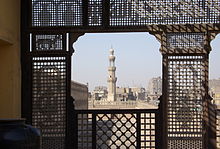In fact, The Gayer-Anderson Museum is an art museum in Cairo, Egypt. It is adjacent to the Mosque of Ahmad ibn Tulun in the Sayyida Zeinab neighborhood. The building takes its name from Major Robert Grenville Gayer-Anderson Pasha, who resided in the house between 1935 and 1942 with special permission from the Egyptian Government. The museum is famous for being one of examples of 17th-century domestic architecture left in Cairo, and also for its collection of furniture, carpets, curio, and other objects.

The Egyptian roof terrace of the Gayer-Anderson Museum
|
Gayer-Anderson Pasha
Robert Grenville Gayer-Anderson joined the Royal Army Medical Corps in 1904 and later transferred to the Egyptian Army in 1907. He was then promoted to become a Major in 1914 and during the same year, he became Assistant Adjutant-General for recruiting in the Egyptian Army. In 1919, he retired from the army to become the Senior Inspector in the Egyptian Ministry of the Interior, and he later became the Oriental Secretary to the British Residency in Cairo. He retired in 1924 but continued to live in Egypt, expanding his interests in Egyptology and Oriental Studies.
History
In fact, Bayt al-Kritliyya is one of the remarkable examples of Muslim domestic architecture in Cairo. It dates back to the Mamluk Period . Built by Hagg Mohamed Salem Galmam el- Gazzar. The museum consists of two houses built using the outer wall of the Mosque of Ibn Tulun as support. The larger house, located to the east (the outermost side in relation to the mosque) . Built by Hajj Mohammad ibn al-Hajj Salem ibn Galman al-Gazzar.
In 1935, Major Gayer-Anderson, a retired collector and self-described Orientalist. Granted permission to reside in the house, which had just restored. Gayer-Anderson oversaw the installation of electricity and plumbing, and the restoration of fountains, pavements, and other parts of the interior of the home. He populated the building with his personal collection of art, furnishings, and carpets. He built a sailing boat he used to collect these antiques from all over Egypt. Docked on the Nile not far from the house.
In 1942, Gayer-Anderson forced by ill health to leave Egypt. He gave the contents of the house to the Egyptian government. King Farouk gave him the title of Pasha in return. Lastly, Gayer-Anderson died in England in 1945, buried in Lavenham, Suffolk.
The James Bond film The Spy Who Loved Me was partially shot in the museum, in the ceremonial reception hall and the rooftop terrace.




Comment (0)